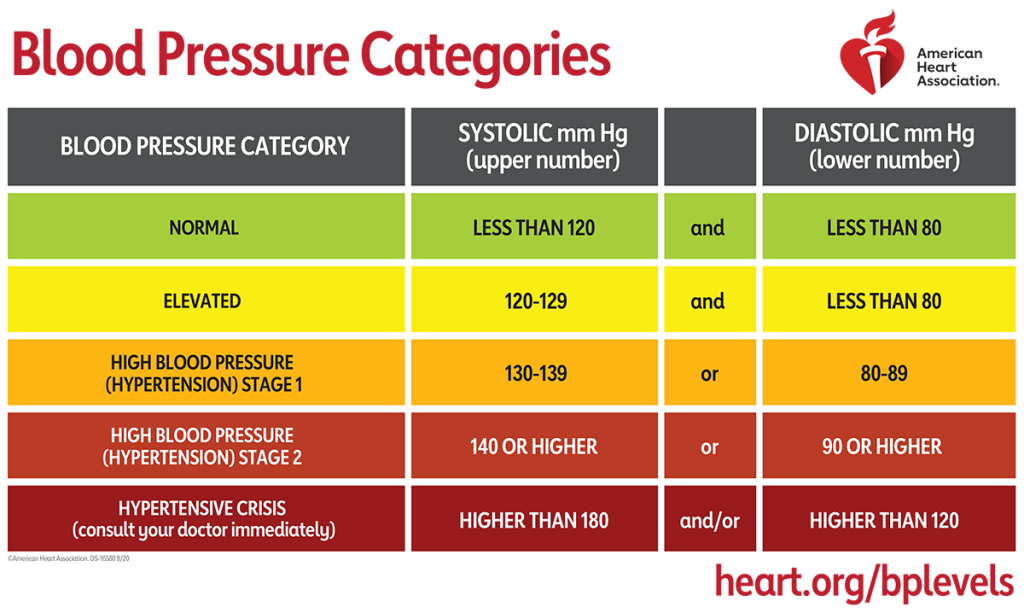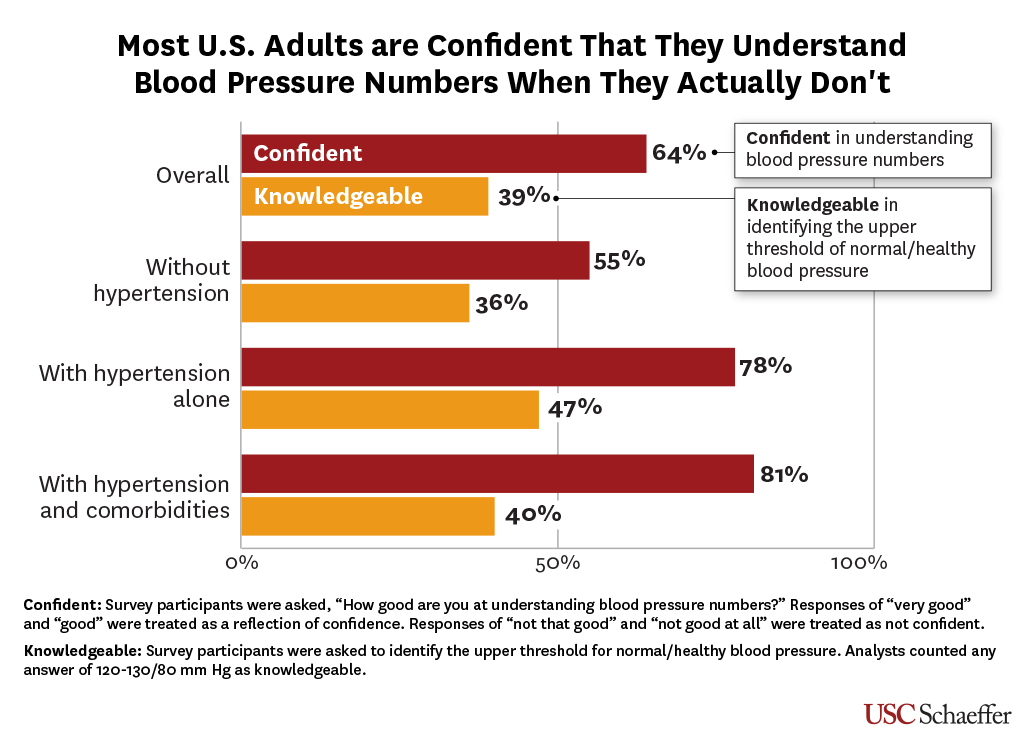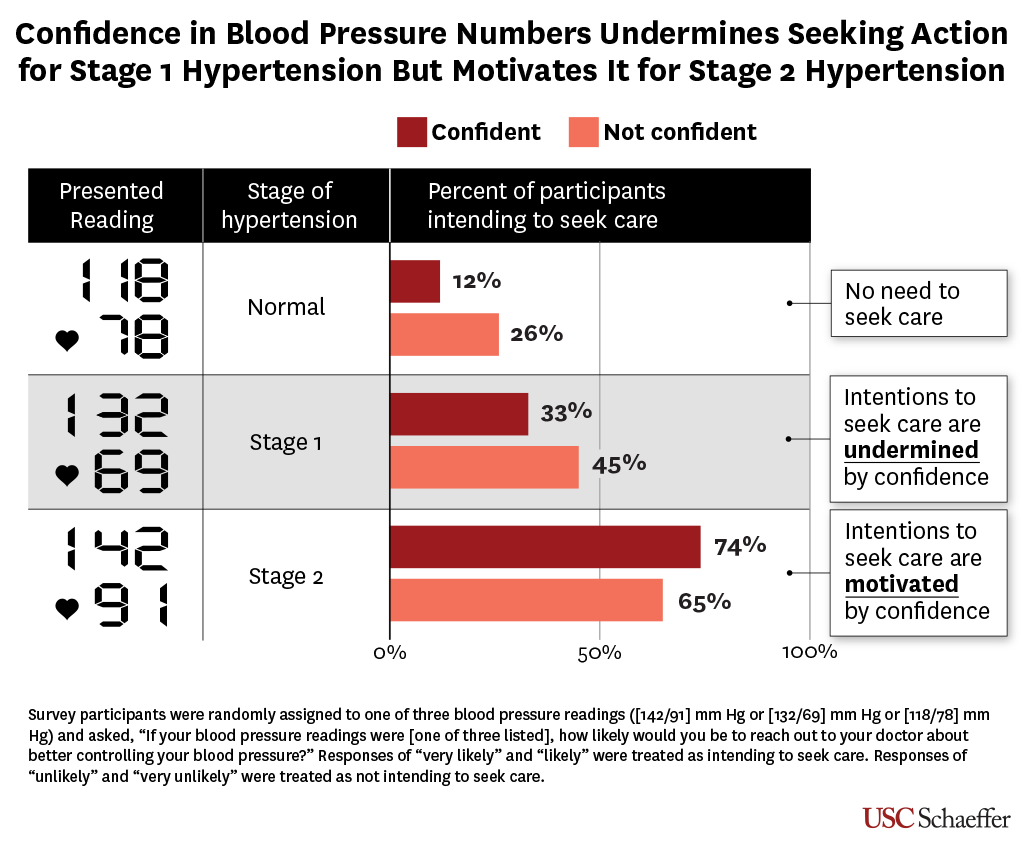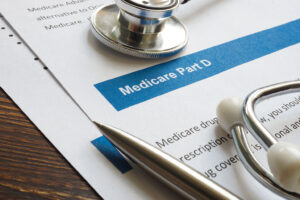Most Americans don’t know the meaning of 120-80 mm Hg, but think they do.
Nearly half of adults in the U.S. have high blood pressure (hypertension). In the long run, high blood pressure damages blood vessels, increases risk of heart failure, and leads to other poor health outcomes, especially in patients with additional conditions such as heart disease, kidney disease and diabetes. High blood pressure is more common as we get older, and a majority of people will develop blood pressure in their lifetime.
Yet, almost two-thirds of adults do not know the upper thresholds for normal or healthy blood pressure, according to a new USC study published this week in the journal Medical Decision Making.
“High blood pressure usually has no symptoms,” said Wandi Bruine de Bruin , who co-directs the Behavioral Sciences program at the USC Schaeffer Center for Health Policy & Economics and is provost professor of public policy, psychology and behavioral sciences at the USC Price School of Public Policy. “So it is important to have your blood pressure tested, and to take action if it’s too high.”
While most survey participants did not correctly identify the threshold for healthy blood pressure, Bruine de Bruin and her team found that the majority were overly confident in their knowledge of blood pressure readings – and this false sense of confidence may be undermining their intentions to seek care for stage 1 hypertension.
What blood pressure numbers mean and when to seek care
Blood pressure is measured with two numbers. The top number, called systolic blood pressure, measures the pressure in our arteries when our hearts beat. The second number is called diastolic blood pressure and measures the pressure in our arteries when our hearts are resting between beats.
According to the American Heart Association, there are five blood pressure (BP) categories:

The American Heart Association recommends that everyone with stage 1 hypertension talk to their doctor about making lifestyle changes, including eating a low-sodium diet, limiting alcohol use, being more physically active, maintaining a healthy weight, managing stress and quitting smoking. Medication is recommended for people with stage 2 hypertension and for some people with stage 1 hypertension, including those who also have heart disease, kidney disease or diabetes.
Confidence outpaces knowledge of what constitutes normal/healthy blood pressure
Bruine de Bruin and colleagues surveyed 6,592 U.S. adults, including 1,342 who had hypertension without comorbidities (heart disease, kidney disease, and diabetes) and 795 who had hypertension with comorbidities. They assessed whether survey participants could identify the threshold for normal/healthy blood pressure as well as their confidence in understanding blood pressure numbers.
Among the whole sample, 64% of participants expressed confidence in their understanding of blood pressure numbers but only 36% stated that 120/80 mm Hg was the upper threshold for normal/healthy blood pressure. When counting 120-130/80 mm Hg as correct, it was 39%.
Participants with high blood pressure without comorbidities were also more likely to be confident (78%) than knowledgeable (47%), when counting 120-130/80 mm Hg as correct. The same was true for participants who had high blood pressure with comorbidities who were slightly more confident (81%) but less knowledgeable (40%).

The researchers suggest that this false confidence may stem from repeated exposure to a topic. “We tend to feel more confident about topics that are more familiar. And blood pressure feels like a familiar topic because it gets measured at pretty much every healthcare visit,” says Bruine de Bruin. “But if these blood pressure measurements are not explained well or at all, we may develop false confidence. And that false confidence makes is feel that we know when to seek care, even when we don’t.”
Indeed, the researchers find that this false confidence in understanding blood pressure readings may undermine intentions to seek care. Survey participants who were confident were more likely to express intentions to act on stage 2 hypertension readings, but less likely to express intentions to act on stage 1 readings compared to those who were not confident.
“Identifying, treating, and controlling high blood pressure is a major clinical and public health challenge,” says coauthor Mark Huffman, professor of Medicine at Washington University in St. Louis. “We know that the earlier patients seek and receive treatment, the better and easier it is to control their blood pressure.”

Every doctor’s visit is an opportunity to talk about blood pressure
“Blood pressure is measured every time we go to the doctor as well as the dentist and other medical offices,” said Bruine de Bruin. “But knowledge about what these blood pressure numbers mean is not being transferred from the provider to the patient.”
It’s not clear why doctors skip opportunities to talk about managing high blood pressure. Possibly, doctors are desensitized to seeing stage 1 hypertension. High pressure is very common among adults across the U.S. Some people also have elevated blood pressure readings due to the stress or anxiety of being at a doctor’s office, which may lead doctors to take no action after seeing a high blood pressure reading.
But lowering blood pressure can help people stay healthy. In fact, a recent study showed that lowering systolic blood pressure by 5 mm Hg through medication reduces the risk of major cardiovascular events by 10%. Providing patients with information about blood pressure levels and behaviors and treatments they can do is an easy way to improve health, explained the researchers.
In addition to Bruine de Bruin and Huffman, Yasmina Okan (Pompeu Fabra University and Centre for Decision Research, Leeds University) and Tamara Krishnamurti (Center for Research on Health Care, University of Pittsburgh) coauthored the study. The survey was administered through the Understanding America Study at the USC Dornsife Center for Economic and Social Research.




